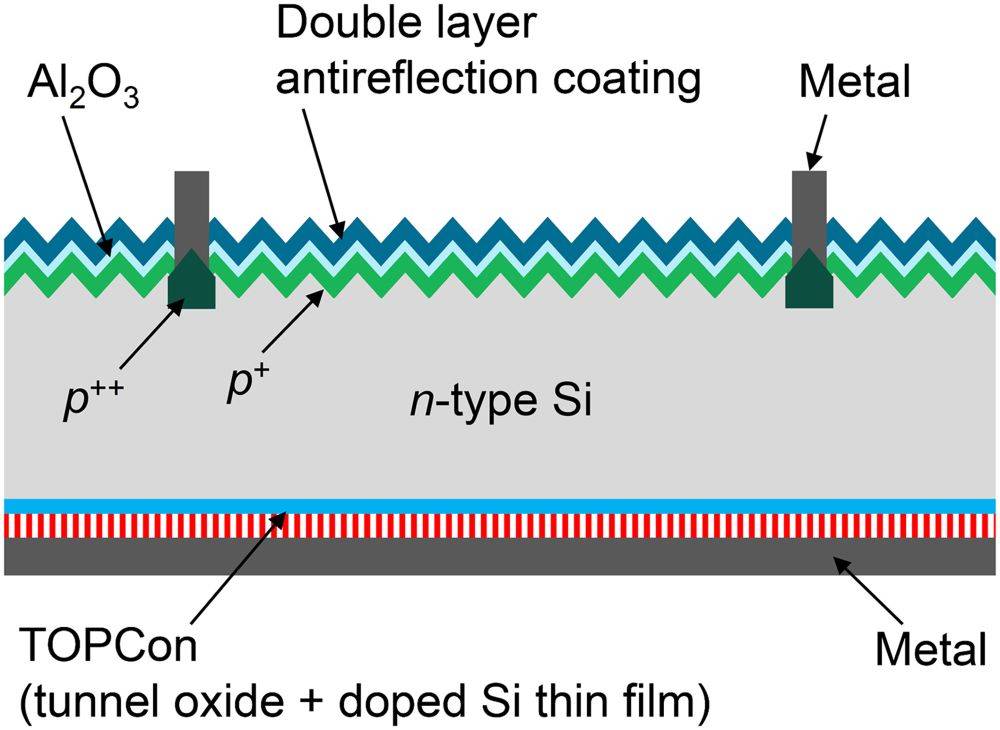钝化层薄膜沉积方法
TOPCon 电池制备的核心流程
TOPCon 电池的制备过程是一连串缜密的步骤,每个步骤对最终产品的整体效率和性能都至关重要。这一过程从以下几个步骤开始 清洁和蓬松 确保硅晶片表面没有可能妨碍后续步骤的污染物。随后是 正面硼扩散 将硼原子引入硅晶格,从而增强电池的电气性能。
接下来是 去除 BSG 和背面蚀刻 以清洁背面,为进一步加工做好准备。然后是 氧化层钝化接触制备 在此过程中,会沉积一层氧化物以钝化硅表面,从而减少重组损耗。正面氧化铝沉积 正面氧化铝沉积 然后再进行正面氧化铝沉积,以提供额外的保护和钝化层。
随后 正面和背面氮化硅沉积 采用化学气相沉积 (CVD) 技术进行,这是整个工艺的关键步骤。化学气相沉积是这一系列工艺中的核心环节,因为它能确保氮化硅的均匀和高质量沉积,而氮化硅对电池的钝化和抗反射性能至关重要。CVD 工艺包括气体混合物在高温下发生化学反应,从而在硅晶片上沉积一层固体薄膜。
氮化硅沉积后,该工艺继续进行 丝网印刷 涂上导电浆料,形成电气触点。随后是 烧结 将导电浆料与硅熔合,形成牢固的电气连接。最后的步骤包括 测试和分类 以确保每个电池在集成到模块之前都能达到所需的性能标准。
总之,TOPCon 电池制备过程是一连串复杂但高度受控的步骤,其中 CVD 在实现所需的钝化和性能特征方面发挥着核心作用。

按成膜方法分类
钝化层薄膜沉积工艺根据成膜方式分为两种主要方法:物理气相沉积 (PVD) 和化学气相沉积 (CVD)。每种方法都有其独特的机制和在光伏产业中的应用。
物理气相沉积法通常是在真空条件下,将材料从源头物理输送到基底。这种方法包括蒸发、溅射和离子束沉积等技术。PVD 因其能够生产出高质量、致密且与基底附着力极佳的薄膜而闻名。不过,与 CVD 相比,PVD 通常需要更复杂的设备,而且大规模生产的效率较低。
另一方面,CVD 依靠气体之间的化学反应将固体薄膜沉积到硅晶片表面。这种方法根据反应条件又分为几个子类别,包括常压 CVD(APCVD)、低压 CVD(LPCVD)、等离子体增强 CVD(PECVD)、高密度等离子体 CVD(HDPCVD)和原子层沉积(ALD)。其中,LPCVD 和 PECVD 因其高效性和可扩展性在 TOPCon 电池制造工艺中尤为突出。
CVD 工艺设备的使用比例较高,凸显了 CVD 在行业中的普遍性。这主要是因为 CVD 能够更高效地处理大规模生产,适应各种电池工艺,而且与 PVD 相比运营成本更低。尽管 CVD 设备的初始投资较高,但其在生产速度和成本效益方面的长期优势使其成为许多制造商的首选。
总之,虽然 PVD 和 CVD 都有各自的优点,但 CVD 在钝化层薄膜沉积工艺中的主导地位证明了它的效率和对大规模光伏生产的适用性。
物理气相沉积(PVD)
物理气相沉积(PVD)是薄膜技术中的一项关键工艺,涉及将材料从固态转变为气态,然后重新沉积到基底上。这种方法通常在低压气体或等离子体条件下使用,有利于在各种基底上形成薄膜。PVD 的主要技术包括 蒸发 和 溅射 每种技术都有不同的运行机制和应用。
蒸发 是一种在真空环境中将源材料加热到其汽化点的过程。这种加热会使材料转变为蒸汽,然后凝结在基底上,形成薄膜。这种方法对低熔点的材料特别有效,通常用于沉积金属和某些电介质材料。
相比之下 溅射 这种方法是利用等离子体对源材料进行离子轰击,通常是氩离子。这种离子轰击会使原子从源材料中脱落,形成蒸汽,随后沉积到基底上。溅射因其能够沉积多种材料而闻名,包括高熔点和复杂成分的材料,使其成为各种工业应用的多功能选择。
PVD 工艺在制造需要精密和功能性薄膜的物品(如电子和光学行业)中至关重要。通过控制温度、压力和等离子条件等沉积参数,可以制造出具有特定机械、光学、化学或电子特性的薄膜。这种精确性使 PVD 成为开发先进技术和高性能部件的基石。
化学气相沉积(CVD)
化学气相沉积(CVD)是一种复杂的真空沉积方法,用于生产高质量、高性能的固体材料,通常用于半导体行业的薄膜沉积。该工艺将硅晶片(基片)暴露在一种或多种挥发性前体中,这些前体在基片表面发生化学反应和/或分解,形成所需的薄膜。这些反应通常会产生挥发性副产品,这些副产品随后会被反应腔内的气流带走。

CVD 技术可根据反应条件(如压力和前驱体类型)进行大致分类。这种分类包括
- 常压 CVD (APCVD):在大气压力下进行。
- 低压化学气相沉积(LPCVD):在减压条件下进行,以提高均匀性和薄膜质量。
- 等离子体增强型 CVD (PECVD):利用等离子体在较低温度下促进化学反应。
- 高密度等离子体化学气相沉积 (HDPCVD):利用高密度等离子体实现卓越的薄膜特性。
- 原子层沉积 (ALD):一种连续的自限制工艺,一次沉积一个原子层。
CVD 的每种变体都具有独特的优势,可根据半导体制造工艺的具体要求(如薄膜均匀性、沉积速率和温度限制)进行选择。
CVD 不仅在半导体制造中举足轻重,在微细加工中也可用于沉积各种材料,包括二氧化硅、碳化物、氮化物和氧氮化物,以及碳纳米管和石墨烯等先进材料。CVD 的多功能性和精确性使其成为薄膜沉积领域不可或缺的技术。
TOPCon 工艺变体
LPCVD(低压气相沉积)
LPCVD 或低压化学气相沉积是一种复杂的热工艺,用于在亚大气压下从气相前驱体中沉积薄膜。这种方法涉及使用一种或几种在低压下发生热分解反应的气态物质。这些反应会在基底表面形成所需的薄膜。工艺条件经过精心选择,以确保生长速度主要由表面反应速度决定,而表面反应速度与温度高度相关。
LPCVD 的温度控制非常精确,因此在晶圆内、晶圆与晶圆之间以及运行与运行之间的变化都非常均匀。这种精度对于保持沉积薄膜质量和性能的一致性至关重要。LPCVD 的低压环境显著提高了反应腔内的气体扩散系数和平均自由路径。这种改善可转化为更好的薄膜均匀性、电阻率均匀性和沟槽覆盖填充能力。低压环境中更快的气体传输速率还有助于快速清除基底上的杂质和反应副产物,从而抑制自掺杂并提高生产效率。

此外,LPCVD 无需使用载气,这大大降低了颗粒污染的可能性。这使得 LPCVD 成为高价值半导体行业沉积薄膜的首选方法。LPCVD 技术的最新进展侧重于实现低应力和多功能能力,进一步扩大了其应用范围,并提高了其在各种工业环境中的性能。
等离子体增强气相沉积(PECVD)
等离子体增强化学气相沉积(PECVD)是一种在基底上沉积薄膜的复杂技术,尤其适用于半导体行业。这种方法利用微波或射频 (RF) 能量在局部产生等离子体,从而显著增强薄膜形成所需的化学反应。与需要较高温度的传统 CVD 工艺不同,PECVD 的工作温度相对较低,通常在 200 至 500°C 之间。这种温度的降低对于半导体晶片等对热敏感的基底来说至关重要,因为它可以最大限度地降低热损伤的风险。
PECVD 中产生的等离子体可直接在基底附近点燃,这种方法被称为直接等离子体技术。这种近距离点火可确保有效利用反应物,从而实现高质量的薄膜沉积。然而,由于潜在的辐射和离子轰击,直接等离子体暴露可能会对敏感基底造成风险,因此必须进行谨慎的过程控制。
PECVD 被广泛用于沉积电介质薄膜,如 SiO₂、Si₃N₄ 和 SiOxNy。该工艺通过射频能量产生反应气体等离子体,促进沉积室内的化学反应。这些反应所需的能量一部分通过将基底加热到中等温度(通常低于 350°C)来提供,另一部分则由等离子体本身提供。这种双重能源可提高沉积薄膜的效率和质量。
PECVD 生产的薄膜用途广泛,可在半导体器件中发挥各种关键作用。这些功能包括用作电容器电介质、化学钝化层、电绝缘体、反应离子蚀刻掩膜和光学防反射涂层。值得注意的是,PECVD 系统具有应力控制、高均匀性、可调折射率和生产保形 SiNₓ 薄膜等先进功能,使其成为许多现代半导体制造工艺的首选。
等离子体增强原子层沉积(PEALD+PECVD)
PEALD+PECVD 是一种协同方法,它将原子层沉积 (ALD) 的精确性和控制性与等离子体增强化学气相沉积 (PECVD) 的高效性和多功能性融为一体。这种混合技术利用了原子层沉积(ALD)的自我限制特性,确保在原子层上沉积出均匀、保形的薄膜,同时利用等离子体增强化学气相沉积(PECVD)的等离子体驱动化学反应,加速沉积过程并提高材料性能。
在 PECVD 中,等离子体环境提供了必要的能量,以促进推动沉积过程的化学反应。等离子体通常使用射频(RF)或微波能量产生,工作压力在 2 到 10 托之间,基底温度在 200 到 400 摄氏度之间。PECVD 的低温操作优势尤为突出,可以使用对温度敏感的基底,否则其他 CVD 技术所需的较高温度就会损害这些基底。
当与 ALD 结合使用时,PECVD 在较低温度下工作的能力变得更加重要。传统上需要精确控制温度和反应物脉冲时间的 ALD 可从等离子体的能量输入中获益,从而提高前驱体的反应活性,并有可能缩短整个工艺时间。二者结合后,薄膜不仅保形性高,而且具有优异的机械和电气性能。
PEALD+PECVD 的应用领域非常广泛,尤其是在半导体和光伏行业。例如,在太阳能电池的生产中,这种技术可用于沉积诸如 SiO2、Si3N4 和 SiOxNy 等电介质薄膜,这些薄膜对于实现高效钝化和抗反射涂层至关重要。这些薄膜对于提高太阳能电池的整体效率和性能至关重要,因此 PEALD+PECVD 成为推动可再生能源解决方案发展的一项关键技术。
此外,通过 PEALD+PECVD 沉积的薄膜具有保形和均匀的特性,因此非常适合用于各种微电子应用,包括电容器电介质、化学钝化层、电绝缘体和反应离子蚀刻掩膜。在原子水平上精确控制薄膜厚度和均匀性的能力确保了这些薄膜能够满足现代半导体器件的严格要求。
总之,PEALD+PECVD 不仅结合了 ALD 和 PECVD 的最佳特性,还为薄膜沉积技术的创新开辟了新的途径。通过将 ALD 的精确性与 PECVD 的高效性相结合,这种混合方法为下一代半导体和光伏设备提供了多功能的强大工具。
PVD(物理气相沉积)
物理气相沉积(PVD)是一种复杂的技术,用于在真空条件下通过物理过程在各种基底上沉积薄膜。这种方法涉及固态或液态材料的气化,然后以蒸汽形式通过受控环境(通常是真空或低压气体或等离子介质)进行传输。到达基底后,气化材料凝结,形成薄膜。
被气化的材料可以是元素、合金或化合物,从而提供了薄膜类型的多样性。值得注意的是,某些 PVD 工艺可通过反应沉积沉积化合物材料。这涉及沉积材料与沉积环境中的气体或共沉积材料的相互作用,例如形成氮化钛 (TiN) 或碳化钛 (TiC)。
PVD 工艺以能够生产厚度从几纳米到几千纳米的薄膜而闻名。这些工艺并不局限于单层薄膜,还可用于制造多层涂层、厚沉积物,甚至独立结构。PVD 沉积薄膜的高纯度和高效率使其在广泛的应用中非常受欢迎,其性能往往超过其他沉积方法生产的薄膜。

PVD 类的主要方法包括溅射和热蒸发。在溅射法中,高能粒子轰击目标材料,导致原子喷射并沉积到基底上。而热蒸发则是将源材料加热至汽化,然后蒸汽在基底上冷凝。这两种方法都能确保材料在真空中逐个原子或分子地传输和积聚,从而产生纯度和效率极高的薄膜。
技术比较
低压化学气相沉积的优缺点
低压化学气相沉积(LPCVD)具有多种优势,尤其是在效率、产量和生产能力方面。其突出特点之一是阶跃覆盖能力强,是复杂三维结构的理想选择,可确保良好的侧壁覆盖。这种能力在光伏电池制造工艺中至关重要,尤其是在生产 TOPCon 电池时。此外,LPCVD 还能在较低温度下进行沉积,有利于保持薄膜的化学成分和微观结构,从而实现良好的成分和结构控制。
不过,LPCVD 也并非没有挑战。该工艺需要保持低压环境,因此能耗相对较高。在 LPCVD 过程中使用大量石英消耗品也会增加运营成本。此外,与等离子体增强化学气相沉积(PECVD)相比,LPCVD 的沉积速率较慢,限制了其生产率。另一个重要问题是旁路电镀现象,即沉积发生在非目标区域,影响最终产品的一致性和质量。
尽管存在这些缺点,但 LPCVD 通过低压环境实现的高薄膜质量仍然是其主要优势,有助于提高均匀性和整体薄膜质量。这种利弊的平衡使 LPCVD 成为光伏行业的一项关键技术,尤其是在 TOPCon 电池生产的复杂过程中。
PECVD 的优缺点
PECVD(等离子体增强化学气相沉积)具有一系列优点,是包括 PERC、TOPCON 和 HJT 在内的各种电池工艺的首选方法。其主要优点之一是 高沉积率 高沉积率。这种效率大大提高了生产吞吐量,使其成为大规模生产的一种省时高效的解决方案。此外,PECVD 还可实现 原位掺杂 在沉积的同时进行掺杂,从而简化了工艺流程。这不仅简化了工作流程,还降低了污染的可能性。
低沉积温度 低沉积温度 PECVD 的另一个关键优势是沉积温度低。通过利用多原子气体放电,这种技术可以在较低的温度下沉积化合物薄膜,从而最大限度地减少对基底的热损伤。这种低温沉积特性对于对高温敏感的基底尤其有利,从而扩大了可用于该工艺的材料范围。此外,PECVD 的 沉积效率高 是由于阴极前的电场分布不均匀,从而将化学反应集中在阴极滴落区。这种局部高活性区域加快了反应速度,提高了沉积效率,直流-PECVD 中 NH3 生成率的分布就说明了这一点。
尽管 PECVD 具有诸多优点,但也并非没有缺点。一个重要的问题是 沉积薄膜的不稳定性 .通过 PECVD 形成的薄膜可能会出现薄膜破裂等问题,从而影响最终产品的完整性和性能。此外,PECVD PECVD 设备的复杂性 需要大量的维护和调试工作,增加了运营成本和复杂性。还存在以下风险 薄膜质量波动 等离子体的不稳定性会影响沉积层的均匀性和一致性。
总之,尽管 PECVD 在沉积速率、工艺简化和成本效益方面具有显著优势,但它也面临着与薄膜稳定性和设备复杂性有关的挑战。在为特定电池工艺选择 PECVD 时,必须仔细考虑这些因素。
PEALD+PECVD 和 PVD 的优势
PEALD+PECVD 和 PVD 在薄膜沉积领域,特别是在光伏电池制造方面,各自具有独特的优势。
PEALD+PECVD 在解决 不均匀性问题 .通过将原子层沉积 (ALD) 的精确性与等离子体增强化学气相沉积 (PECVD) 的高效性相结合,这种混合技术可确保整个基板上的薄膜厚度和成分均匀一致。这对于保持一致的电气性能和提高光伏电池的整体效率至关重要。PECVD 的沉积温度较低,通常低于 350°C,可确保基底上的热应力最小,这对塑料等对温度敏感的材料尤其有利。此外,等离子体中的高能粒子还可提高 PECVD 的沉积效率,从而进一步加快薄膜的形成速度,并使其得到更好的控制。
另一方面、 PVD 的突出特点是 快速成膜 和 多功能升级 .与依靠化学反应的 PECVD 不同,PVD 采用蒸发、溅射或离子束技术等物理过程将材料沉积到基底上。这使得薄膜形成迅速,使 PVD 成为要求快速周转时间的应用的理想选择。此外,PVD 还具有以下优势 无缠绕电镀 此外,PVD 还具有无需缠绕电镀的优势,确保沉积的薄膜不会因机械应力而产生缺陷。PVD 技术的多功能性还允许进行多功能升级,可沉积具有定制特性的复杂多层结构。
不过,值得注意的是,虽然 PVD 和 PEALD+PECVD 具有这些引人注目的优势,但它们的设备成本也较高。这些先进沉积技术所需的精密机械需要大量投资,这可能是制造商在平衡成本和性能时需要考虑的因素。
总之,虽然 PEALD+PECVD 和 PVD 在薄膜沉积方面都具有独特的优势,但它们的选择取决于应用的具体要求,包括对薄膜均匀性、沉积速度和成本效益的考虑。
相关产品
- 倾斜旋转等离子体增强化学气相沉积 PECVD 设备管式炉
- RF PECVD 系统 射频等离子体增强化学气相沉积 RF PECVD
- 化学气相沉积CVD设备系统腔体滑动PECVD管式炉带液体气化器PECVD设备
- 倾斜旋转等离子体增强化学气相沉积PECVD设备管式炉
- 薄层光谱电解电化学池














